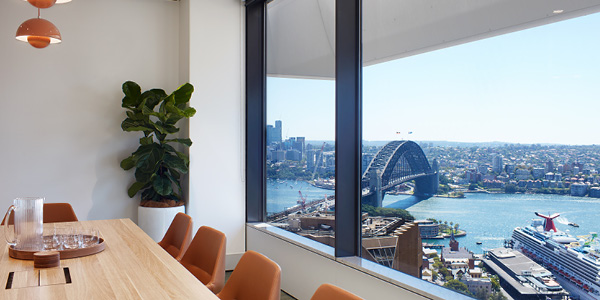
The ongoing evolution of office space is a hot focus area for climate change mitigation as the drive to measure and reduce carbon impacts on our environment accelerates towards increasing regulation and compliance rules in the building industry, particularly for commercial offices. The Green Building Council Australia (GBCA) estimates that embodied carbon in commercial offices could be responsible for 85% of the built environment’s carbon emissions.
A recent study commissioned by Grosvenor Place management is putting leading edge management of our carbon impact into action and providing a valuable tool we can now utilise across our tenancies to future-proof our offices and operations in this era.
We undertook a recent whole office refurbishment at Suite 32.04, choosing to implement an adaptive reuse approach rather than a full refit in line with our drive for top performance in sustainability outcomes.
The major step in improving our contribution to carbon reduction is to understand where and what our carbon impact is and measure it accurately to incorporate realistic and valuable outcomes. The Suite 32.04 adaptive reuse refit was a perfect test case to trial the reporting approach with our ambition to implement this on all future fit-outs in the tower.
The Footprint Company (TFC) was tasked post the project with creating a full assessment of the program as well as comparative ways the refit could have been conducted and to compare the results with recommendations for the rest of the building.
Firstly, TFC quantified the embodied carbon in the existing footprint and for the project. The proposal for the adaptive refit plan specifically reused existing finishes and built structures like internal walls, carpet flooring, and the plasterboard grid ceiling.
This TFC study used globally relevant and validated benchmarking for Class 5 A grade office buildings to deduce the embodied carbon, including scope 1 and 2 emissions, and found the project achieved a best-in-class rating 4 Star performance level using the circular economy principles of adaptive reuse.
Some 41,052 kg CO2 was saved over other refit options, the equivalent of over 23% of the new fit-out proposal with the headline outcome being the equivalent of saving 4 years of operational energy.
The report went further to assess the potential additional savings that could have been achieved if the assessment had been done prior to the fit-out and incorporated further the adaptive reuse design process, identifying a further 16% potential mitigation.
The impressive findings make it obvious that embodied carbon measurement and strategies need to be implemented from feasibility and through the design development stages of future works to maximise benefits, savings, and impacts.
Grosvenor Place is now able to provide this tool or 5-star carbon advisory ratings to tenants to drive their own savings and efficiency. The entire building asset will hold a central carbon management software allowing consistent benchmarking and reporting to meet compliance requirements.
Stringent regulation is coming to make carbon reduction and reporting mandatory, and the likelihood of caps being introduced can flag both a risk and an opportunity to be realised where a building like Grosvenor Place can provide asset management plans that optimise the life cycle.
By delivering quantifiable and high-quality data, we can enhance our leadership in encouraging tenants to implement carbon advisory across all their projects and leading the way to maximise reuse by showcasing the obvious benefits. This leadership on climate mitigation and the impressive results and benefits can start to be implemented as policy measures to improve performance across our asset.
TFC believes Grosvenor Place can create a carbon benefit of between 20% and 40% compared to standard tenancies by implementing this assessment and strategy for refits. Apart from the savings and benefits, the assessments can be utilised for many sustainability compliance requirements such as Greenstar and NABERS, passing on these attributes to tenants for reporting.
This methodology and approach will be the future standard practice we implement for fit-outs to maximise our impact and continue our drive to be at the leading edge of sustainability and compliance.
You can take a tour of suite 32.04 here.

